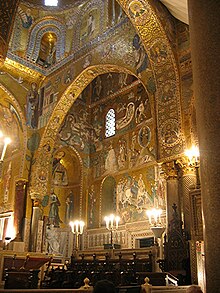

Islamic influences on Western art refers to the stylistic and formal influence of Islamic art, defined as the artistic production of the territories ruled by Muslims from the 7th century onward, on European Christian art. Western European Christians interacted with Muslims in Europe, Africa, and the Middle East and formed a relationship based on shared ideas and artistic methods.[1] Islamic art includes a wide variety of media including calligraphy, illustrated manuscripts, textiles, ceramics, metalwork, and glass, and because the Islamic world encompassed people of diverse religious backgrounds, artists and craftsmen were not always Muslim, and came from a wide variety of different backgrounds. Glass production, for example, remained a Jewish speciality throughout the period. Christian art in Islamic lands, such as that produced in Coptic Egypt or by Armenian communities in Iran, continued to develop under Islamic rulers.
Islamic decorative arts were highly valued imports to Europe throughout the Middle Ages. In the early period, textiles were especially important, due to the labor-intensive nature of their production. These textiles originating in the Islamic world were frequently used for church vestments, shrouds, hangings and clothing for the elite. Islamic pottery of everyday quality was still preferred to European wares.[2]
In the early centuries of Islam, the most important points of contact between the Latin West and the Islamic world from an artistic point of view were Southern Italy, Sicily, and the Iberian peninsula, which both held significant Muslim populations. Later the Italian maritime republics were important in trading artworks. In the Crusades, Islamic art seems to have had relatively little influence even on the Crusader art of the Crusader kingdoms, though it may have stimulated the desire for Islamic imports among Crusaders returning to Europe. Islamic architecture, however, appeared to influence the designs of Templar churches within the Middle East and other cathedrals within Europe upon the return of Crusaders in the 12th and 13th century.[3]
Numerous techniques from Islamic art formed the basis of art in the Norman-Arab-Byzantine culture of Norman Sicily, much of which used Muslim artists and craftsmen working in the style of their own tradition. Techniques included inlays in mosaics or metals, often used for architectural decoration, porphyry or ivory carving to create sculptures or containers, and bronze foundries.[4] In Iberia the Mozarabic art and architecture of the Christian population living under Muslim rule remained very Christian in most ways, but showed Islamic influences in other respects; much what was described as this is now called Repoblación art and architecture. During the late centuries of the Reconquista Christian craftsmen started using Islamic artistic elements in their buildings, as a result the Mudéjar style was developed.

Islamic art was widely imported and admired by European elites during the Middle Ages.[5] There was an early formative stage from 600-900 and the development of regional styles from 900 onwards. Early Islamic art used mosaic artists and sculptors trained in the Byzantine and Coptic traditions.[6] Instead of wall-paintings, Islamic art used painted tiles, from as early as 862-3 (at the Great Mosque of Kairouan in modern Tunisia), which also spread to Europe.[7] According to John Ruskin, the Doge's Palace in Venice contains "three elements in exactly equal proportions — the Roman, the Lombard, and Arab. It is the central building of the world. ... the history of Gothic architecture is the history of the refinement and spiritualization of Northern work under its influence".[8]

Throughout the Middle Ages, Islamic rulers controlled at various points parts of Southern Italy, the island of Sicily, and most of modern Spain and Portugal, as well as the Balkans, all of which retained large Christian populations. The Christian Crusaders also held territory in regions of the Islamic world, and ruled over some Muslim populations. Crusader art is mainly a hybrid of Catholic and Byzantine styles, showing little Islamic influence; however, the Mozarabic art of Christians in Al Andalus seems to show considerable influence from Islamic art. Islamic influence can also be traced in Romanesque and Gothic art in northern European art. For example, in the Romanesque portal at Moissac in southern France, the scalloped edges to the doorway and the circular decorations on the lintel above, have parallels in Iberian Islamic art. The depiction of Christ in Majesty surrounded by musicians, which was to become a common feature of Western heavenly scenes, may derive from courtly images of Islamic rulers.[11] Calligraphy, ornament, and the decorative arts generally were more important than in the West.[12]
The Hispano-Moresque pottery wares of Spain were first produced in Al-Andalus, but Muslim potters then seem to have emigrated to the area of Christian Valencia. Here they produced work that was exported to Christian elites across Europe;[13] other types of Islamic luxury goods, notably silk textiles and carpets, came from the generally wealthier[14] eastern Islamic world itself (the Islamic conduits to Europe west of the Nile were, however, not wealthier),[15] with many passing through Venice.[16] However, for the most part luxury products of the court culture such as silks, ivory, precious stones and jewels were imported to Europe only in an unfinished form and manufactured into the end product labelled as "eastern" by local medieval artisans.[17] They were free from depictions of religious scenes and normally decorated with ornament, which made them easy to accept in the West,[18] indeed by the late Middle Ages there was a fashion for pseudo-Kufic imitations of Arabic script used decoratively in Western art.

Until the end of the Middle Ages, many European produced goods could not match the quality of objects originating from areas in the Islamic world or the Byzantine Empire. Because of this, a wide variety of portable objects from various decorative arts were imported from the Islamic world into Europe during the Middle Ages, mostly through Italy, and above all Venice.[19] Venetians visited cities like Damascus, Cairo, and Aleppo throughout the Middle Ages. When they would visit these Muslim centers, they would bring back new ideas for art and architecture. The city of Venice was built with a Christian population in mind, but implemented many classic Islamic elements, and the merchant-city reputation of Venice helped solidify the blend of Islamic and Christian cultures at the time.[20] In many areas European-made goods could not match the quality of Islamic or Byzantine work until near the end of the Middle Ages. Luxury textiles were widely used for clothing and hangings and also, fortunately for art history, also often as shrouds for the burials of important figures, which is how most surviving examples were preserved. In this area Byzantine silk was influenced by Sassanian textiles, and Islamic silk by both, so that is hard to say which culture's textiles had the greatest influence on the Cloth of St Gereon, a large tapestry which is the earliest and most important European imitation of Eastern work. European, especially Italian, cloth gradually caught up with the quality of Eastern imports, and adopted many elements of their designs.
Byzantine pottery was not produced in high-quality types, as the Byzantine elite used silver instead. Islam has many hadithic injunctions against eating off precious metal, and so developed many varieties of fine pottery for the elite, often influenced by the Chinese porcelain wares which had the highest status among the Islamic elites themselves — the Islamic only produced porcelain in the modern period. Much Islamic pottery was imported into Europe, dishes (bacini) even in Islamic Al-Andalus in the 13th century, in Granada and Málaga, where much of the production was already exported to Christian countries. Many of the potters migrated to the area of Valencia, long reconquered by the Christians, and production here outstripped that of Al-Andalus. Styles of decoration gradually became more influenced by Europe, and by the 15th century the Italians were also producing lustrewares, sometimes using Islamic shapes like the albarello.[21] Metalwork forms like the zoomorphic jugs called aquamanile and the bronze mortar were also introduced from the Islamic world.[22]
Mudéjar art is a style influenced by Islamic art that developed from the 12th century until the 16th century in the Iberia's Christian kingdoms. It is the consequence of the convivencia between the Muslim, Christian and Jewish populations in medieval Spain. The elaborate decoration typical of Mudéjar style fed into the development of the later Plateresque style in Spanish architecture, combining with late Gothic and Early Renaissance elements.
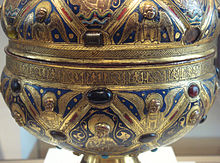
The Arabic Kufic script was often imitated in the West during the Middle-Ages and the Renaissance, to produce what is known as pseudo-Kufic: "Imitations of Arabic in European art are often described as pseudo-Kufic, borrowing the term for an Arabic script that emphasizes straight and angular strokes, and is most commonly used in Islamic architectural decoration".[23] Numerous cases of pseudo-Kufic are known in European religious art from around the 10th to the 15th century. Pseudo-Kufic would be used as writing or as decorative elements in textiles, religious halos or frames. Many are visible in the paintings of Giotto.[23]
Examples are known of the incorporation of Kufic script such as a 13th French Master Alpais' ciborium at the Louvre Museum.[N 1][24]
An example of this blended art style can be seen in the Mantle of Roger II. Designed in Norman Sicily, it went on to be the coronation garb for the Holy Roman Empire. The mantle depicts lions overcoming camels, symbolic imagery to allude to the Norman conquering of Arab territory. This symbol also draws from Islamic cultures' usage of the lion as a symbol of victory at the time, though it flips the context, as it is being used to depict the Norman victory over the Arabs.[25] The inscription on the mantle is also written in Arabic, referencing the culture and language of the lands they overthrew.
The Normans of Sicily were located at a crossroads between European Christian cultures, and the Islamic worlds of Spain, North Africa, Western Asia. Though they were a Christian culture, the lands they ruled over had been previously occupied by Arab Islamic rule until the Normans overtook it in 1060,[25] and their art style reflects this previous Arab leadership and existence at a middle ground in the Medieval world.[25]
Christian buildings such as the Cappella Palatina in Palermo, Sicily, incorporated Islamic elements, probably usually created by local Muslim craftsmen working in their own traditions. The ceiling at the Cappella, with its wooden vault arches and gilded figurines, has close parallels with Islamic buildings in Fez and Fustat, and reflect the Muqarnas (stalactite) technique of emphasizing three-dimensional elements[26]
The diaphragm arch, Late Antique in origin, was widely used in Islamic architecture, and may have spread from Spain to France.[27]
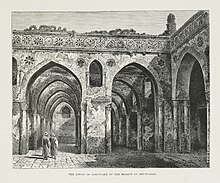
Western scholars of the 18–19th century, who generally preferred Classical art characterized Gothic art as "disorder[ed]”, causing several to draw similarities between Gothic and Islamic architecture. The theory that the Gothic architectural style was influenced by Islamic architecture was made widely known by Sir Christopher Wren in his Parentalia (1750). Wren argued that the pointed arch and ribbed-vaulting characteristics of the Gothic style were borrowed from the Saracens, typically Arab Muslims, therefore Gothic art should be called the “Saracen style” of architecture.[28] William Hamilton commented on the Seljuks monuments in Konya: "The more I saw of this peculiar style, the more I became convinced that the Gothic was derived from it, with a certain mixture of Byzantine (...) the origin of this Gotho-Saracenic style may be traced to the manners and habits of the Saracens"[N 3][29]
The 8th century Umayyad Caliphate within the Iberian peninsula was credited with introducing many elements adopted into Gothic architecture within Spain, and Christian Crusaders returning home to Europe in the 12th and 13th century carried Islamic architectural influences with them into France and later England.[3] Several attributes of Gothic architecture have been biasedly attributed to being borrowed from Islamic styles. The 18th-century English historian Thomas Warton summarized:
"The marks which constitute the character of Gothic or Saracenical architecture, are, its numerous and prominent buttresses, its lofty spires and pinnacles, its large and ramified windows, its ornamental niches or canopies, its sculptured saints, the delicate lace-work of its fretted roofs, and the profusion of ornaments lavished indiscriminately over the whole building: but its peculiar distinguishing characteristics are, the small cluttered pillars and pointed arches, formed by the segments of two interfering circles"
— Thomas Warton Essays on Gothic architecture[N 4]
When Sir. Christopher Wren constructed St. Paul’s Cathedral in London, he admitted the use of “Saracen vaulting,” referring to the ribbed-vaulting typical of Islamic mosques, such as in the Great Mosque of Cordoba.[3]
Wren’s attribution of the Gothic’s style’s pointed arch to Islamic architecture was affirmed by 21st century scholar Diana Darke, who in Stealing from the Saracens: How Islamic Architecture Shaped Europe explains that the pointed arch first appeared in the 7th century Dome of the Rock in Jerusalem, which was built by the Umayyad caliph Abd al-Malik.[3] Furthermore, the trefoil arch, which was adopted by Gothic architects to symbolize the Holy Trinity, first appeared within Umayyad shrines and palaces before it was seen in European architecture.[3] Darke’s argument that Western Gothic art was borrowed directly from Islamic art has been criticized for ignoring cross-cultural influences in Islamic art itself, which make it difficult to determine which architectural elements were created by whom in a strictly linear evaluation.[3]
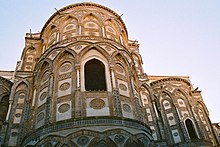
The pointed arch originated in the Byzantine and Sassanian empires, where it mostly appears in early churches in Syria. The Byzantine Karamagara Bridge has curved elliptical arches rising to a pointed keystone.[30] The priority of the Byzantines in its use is also evidenced by slightly pointed examples in Sant'Apollinare in Classe, Ravenna, and the Hagia Irene, Constantinople.[30] The pointed arch was subsequently adopted and widely used by Muslim architects, becoming the characteristic arch of Islamic architecture.[30] According to Bony, it has spread from Islamic lands, possibly through Sicily, then under Islamic rule, and from there to Amalfi in Italy, before the end of the 11th century.[31][32] The pointed arch reduced architectural thrust by about 20% and therefore had practical advantages over the semi-circular Romanesque arch for the building of large structures.[31]
The pointed arch as a defining characteristic of Gothic architecture appears to have been introduced from the Islamic, in some areas, but to have evolved as a structural solution in late Romanesque, both in England at Durham Cathedral and in the Burgundian Romanesque and Cistercian architecture of France.[33]
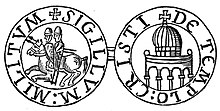
In 1119, the Knights Templar received as headquarters part of the Al-Aqsa Mosque in Jerusalem, considered by the crusaders the Temple of Solomon, from which the order took its common name. Around a decade later, the royal palace moved their headquarters to near the Temple of David, and the Knights Templar took over all of the Al-Aqsa Mosque. Subsequently, the Templar order built secular and religious structures within the mosque’s area, like multiple cloisters, shrines, and a church. It's likely that the Templars used the Dome of the Rock, also known as al-Haram al-Sharif, as a standard to reach in terms of architectural beauty.[34] The typical round churches built by the knights across Western Europe, such as the London Temple Church, may have been influenced by the shape of Al-Aqsa or the Dome of the Rock (known to Muslims as al-Haram al-Sharif), though it's possible they are also referencing the nearby rotunda in the Church of the Holy Sepulchre[35] Both Al-Aqsa and the Holy Sepulchre likely draw influence from Roman mausolea such as the Mausoleum of Augustus, round churches of early Christianity such as Santa Costanza in Rome, and Byzantine interpretations such as Basilica of San Vitale in Ravenna.
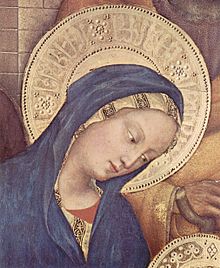
Pseudo-Kufic is a decorative motif that resembles Kufic script and occurs in many Italian Renaissance paintings. The exact reason for the incorporation of pseudo-Kufic in early Renaissance works is unclear. It seems that Westerners mistakenly associated 13th–14th-century Middle-Eastern scripts as being identical with the scripts current during Jesus's time, and thus found natural to represent early Christians in association with them:[37] "In Renaissance art, pseudo-Kufic script was used to decorate the costumes of Old Testament heroes like David".[38] Mack states another hypothesis:
Perhaps they marked the imagery of a universal faith, an artistic intention consistent with the Church's contemporary international program.[39]

Carpets of Middle-Eastern origin, either from the Ottoman Empire, the Levant or the Mamluk state of Egypt or Northern Africa, were used as important decorative features in paintings from the 13th century onwards, and especially in religious painting, starting from the Medieval period and continuing into the Renaissance period.[40]
Such carpets were often integrated into Christian imagery as symbols of luxury and status of Middle-Eastern origin, and together with Pseudo-Kufic script offer an interesting example of the integration of Eastern elements into European painting.[40]
Anatolian rugs were used in Transylvania as decoration in Evangelical churches.[41]

Islamic individuals and costumes often provided the contextual backdrop to describe an evangelical scene. This was particularly visible in a set of Venetian paintings in which contemporary Syrian, Palestinian, Egyptian and especially Mamluk personages are employed anachronistically in paintings describing Biblical situations.[42] An example in point is the 15th century The Arrest of St. Mark from the Synagogue by Giovanni di Niccolò Mansueti which accurately describes contemporary (15th century) Alexandrian Mamluks arresting Saint Mark in an historic scene of the 1st century CE.[42] Another case is Gentile Bellini's Saint Mark Preaching in Alexandria.[43]
A Western style of ornament based on the Islamic arabesque developed, beginning in late 15th century Venice; it has been called either moresque or western arabesque (a term with a complicated history). It has been used in a great variety of the decorative arts but has been especially long-lived in book design and bookbinding, where small motifs in this style have continued to be used by conservative book designers up to the present day. It is seen in gold tooling on covers, borders for illustrations, and printer's ornaments for decorating empty spaces on the page. In this field the technique of gold tooling had also arrived in the 15th century from the Islamic world, and indeed much of the leather itself was imported from there.[44]
Like other Renaissance ornament styles it was disseminated by ornament prints which were bought as patterns by craftsmen in a variety of trades. Peter Furhring, a leading specialist in the history of ornament, says that:
The ornament known as moresque in the fifteenth and sixteenth centuries (but now more commonly called arabesque) is characterized by bifurcated scrolls composed of branches forming interlaced foliage patterns. These basic motifs gave rise to numerous variants, for example, where the branches, generally of a linear character, were turned into straps or bands. ... It is characteristic of the moresque, which is essentially a surface ornament, that it is impossible to locate the pattern's beginning or end. ... Originating in the Middle East, they were introduced to continental Europe via Italy and Spain ... Italian examples of this ornament, which was often used for bookbindings and embroidery, are known from as early as the late fifteenth century.[45]
Elaborate book bindings with Islamic designs can be seen in religious paintings.[46] In Andrea Mantegna's Saint John the Baptist and Zeno, Saint John and Zeno hold exquisite books with covers displaying Mamluk-style center-pieces, of a type also used in contemporary Italian book-binding.[47]
Moorish architecture appeared in the Americas as early as the arrival of the Spanish led by Christopher Columbus in 1492. Many of the settlers from Spain were craftsmen and builders that converted to Christianity from Islam, bringing "domes, eight-pointed stars, quatrefoil elements, ironwork, courtyard fountains, balconies, towers, and colorful tiles" as noted by historian Phil Pasquini.[48] The oldest building in the United States of America that was influenced by Islamic architecture is the Alamo. One of five missions in the area, it was supposed to include a dome and tower as per Moorish design, but was left in ruins after the battle of the Alamo in 1836.[48]
After the attacks of September 11, 2001, Islamic art and architecture has seen a decline in popularity in the United States. There are a few popular Islamic influenced tourist attractions in the United States, such as the Morocco pavilion in Disney's Epcot, the Irvine Spectrum Center in Irvine, California, and the Islamic-themed city of Opa-Locka, Florida.[48]
((cite book)): CS1 maint: multiple names: authors list (link)
| Architecture |
| ||||||||||||
|---|---|---|---|---|---|---|---|---|---|---|---|---|---|
| Arts |
| ||||||||||||
| Arts of the book |
| ||||||||||||
| Decoration |
| ||||||||||||
| The garden | |||||||||||||
| Museums, collections |
| ||||||||||||
| Exhibitions | |||||||||||||
| Principles, influences | |||||||||||||
| Arts | |
|---|---|
| Economics | |
| History | |
| Law and politics | |
| Philosophy | |
| Medieval science | |
| Other fields | |